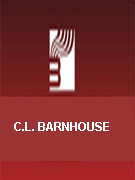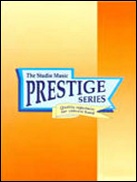Results
-
 £37.62
£37.62Old Glory (Concert Band - Score and Parts)
An exciting rock tune that includes an optional section where you can give any of your students a chance to play an improvised solo. Includes parts for Keyboard, Electric Bass and Drum Set and solo sheets to help your young players understand the chords and scales to the solo section. A perfect way to introduce improvisation to all of your students!
Estimated dispatch 7-14 working days
-
 £184.95
£184.95PARTITA for Concert Band (Darrol Barry) (Prestige Concert Band - Score and Parts) - Barry, Darrol
This work is cast in four movements: Introit; Impromptu; Elegy (31.12.04); Finale. Grade 5. (Recorded on QPRM150D, CHIVALRY, Royal Northern College of Music Wind Orchestra) PARTITA FOR CONCERT BAND is cast in four movements: Introit - begins majestically with brass, saxes and percussion carrying the main theme from which most of the following ideas originate. It is repeated by the woodwinds and moves via a solo side drum into the piu mosso. New ideas are introduced by trombones, the horns and euphoniums leading to the central idea played by oboe. This leads, in turn, via full band to the closing movement. 2. Impromptu -once again the opening theme is the basis of the whole movement, using most of the composer's tricks, augmentation, retrograde, inversion and fugato, it moves along in a very confident style. A muted solo trumpet links into the third movement. Elegy (26/12/04) - this movement was prompted by the devastating events of Boxing Day 2004, the Asian Tsunami. The movement opens bleakly until a solo flute gives us the main theme over a troubled accompaniment. The opening mood returns but timpani and tam-tam herald return of the main theme for the full band. The opening theme is heard again as the music subsides but never settles. Finale - this spirited 6/8 vivo opens up with percussion and horns and trumpets announce the main idea, punctuated with short chords from the lower band. A new four bar theme is heard over a bass tread, the theme overlaps itself and quavers swirl up and down the band. Material from the first movement is heard transformed by the energy of the finale and the music surges towards a sudden close. Performance time: 15:35
Estimated dispatch 7-14 working days
-
 £44.95
£44.95PARTITA for Concert Band (Darrol Barry) (Prestige Concert Band - Score only) - Barry, Darrol
This work is cast in four movements: Introit; Impromptu; Elegy (31.12.04); Finale. Grade 5. (Recorded on QPRM150D, CHIVALRY, Royal Northern College of Music Wind Orchestra) PARTITA FOR CONCERT BAND is cast in four movements: Introit - begins majestically with brass, saxes and percussion carrying the main theme from which most of the following ideas originate. It is repeated by the woodwinds and moves via a solo side drum into the piu mosso. New ideas are introduced by trombones, the horns and euphoniums leading to the central idea played by oboe. This leads, in turn, via full band to the closing movement. 2. Impromptu -once again the opening theme is the basis of the whole movement, using most of the composer's tricks, augmentation, retrograde, inversion and fugato, it moves along in a very confident style. A muted solo trumpet links into the third movement. Elegy (26/12/04) - this movement was prompted by the devastating events of Boxing Day 2004, the Asian Tsunami. The movement opens bleakly until a solo flute gives us the main theme over a troubled accompaniment. The opening mood returns but timpani and tam-tam herald return of the main theme for the full band. The opening theme is heard again as the music subsides but never settles. Finale - this spirited 6/8 vivo opens up with percussion and horns and trumpets announce the main idea, punctuated with short chords from the lower band. A new four bar theme is heard over a bass tread, the theme overlaps itself and quavers swirl up and down the band. Material from the first movement is heard transformed by the energy of the finale and the music surges towards a sudden close. Performance time: 15:35
Estimated dispatch 7-14 working days
-
£420.99
Tre Sentimenti Wind Band Set (Score & Parts)
At last the bass clarinet can shine in this major new solo work for bass clarinet and concert band. This composition begins with a rather mysterious opening passage with atmospheric sounds and effects. The soloist plays - preferably backstage - a number of fragments and melodic patterns, without actually "starting" the piece. After this somewhat hesitant introduction, a lively, cheerful allegro entitled Con Giocondita (with joy) bursts out. It is swarming with irregular meters, changing tempos, and polyrhythm, through which the listeners (and sometimes also the musicians) constantly get the feeling that they are being tossed around. The second movement brings rest and peace making careful use of sound colours. The upbeat finale, titled Con Allegria (with cheerfulness), is the most significant movement for the soloist. This is a challenging piece of music that demands great virtuosity, but with the correct performer it will be a real highpoint in any concert..
Estimated dispatch 7-14 working days
-
 £87.70
£87.70Introduction and Rondo Capriccioso - Camille Saint-Saëns
A brilliant transcription of this very famous violin solo, utilizing a more chamber-like wind ensemble scoring in order to maintain the delicate balance between the soloist and ensemble. Instrumentation: Solo Flute, C Flute 1, C Flute 2, Oboe 1, Oboe 2, Clarinet 1, Clarinet 2, Bass Clarinet, Bassoon, Horn 1, Horn 2, Trumpet 1, Trumpet 2, Euphonium (T.C. and B.C.), Tuba, Timpani
Estimated dispatch 7-14 working days
-
 £61.70
£61.70LEncore For Flute, Clarinet and Concert Band - Victor Herbert
Instrumentation: Solo Flute, Solo Clarinet, Flute, Oboe, Clarinet 1, Clarinet 2, Bass Clarinet, Alto Saxophone, Tenor Saxophone, Baritone Saxophone, Bassoons, Horn 1, Horn 2, Trumpet 1, Trumpet 2, Trombone, Euphonium, Tuba, Timpani, Triangle, Cymbal
Estimated dispatch 7-14 working days
-
 £78.99
£78.99Double Concerto - Antonio Vivaldi
This famous Allegro movement from a Vivaldi concerto for two trumpets is presented here in an arrangement loaded with flexibility as to choice of soloists and even the accompanying ensemble. May be performed as a solo or as a duet, and it includes solo/duet parts for Bb instruments: Trumpets or Clarinets; C Instruments: Flutes, Oboes, or Violins; Eb Instruments: Alto Saxophones; F Instruments: Horns; and Bass Clef instruments: Bassoons or Trombones. The accompaniment is cleverly scored so that it is playable by a full, traditional concert band; or by a "chamber wind ensemble" of woodwinds, horns, and timpani (ideal for accompanying upper woodwind soloists.) A great way to feature outstanding soloists from your band!
Estimated dispatch 7-14 working days
-
 £80.99
£80.99Hungarian Rondo - Carl Maria von Weber
Composed by Carl Maria von Weber for solo viola with orchestra, the "Hungarian Rondo" has become a standard repertoire bassoon solo. This edition offers a choice of soloist, including bassoon, bass clarinet, euphonium, or tuba. The band setting is carefully arranged to require a minimum of preparation time, and is playable with either full concert band, or if accompanying a soloist requiring greater presence, just woodwinds and horns. The finale includes an ossia part as well as the original. An excellent piece to feature a guest artist or outstanding soloist with your band!
Estimated dispatch 7-14 working days
-
£54.99
Over the Waves - Rosas
Instrumentation: Db Piccolo, C Flute and Piccolo, Eb Clarinet, 1st Bb Clarinet, 2nd & 3rd Bb Clarinets. Eb Cornet, Solo Bb Cornet, 1st Bb Cornet, 2nd & 3rd Bb Cornets, Solo Alto, 1st & 2nd Altos, 1st Trombone, 2nd Trombone, 3rd Trombone, 1st Bb Tenor, 2nd Bb Tenor, Bb Bass (3rd Trombone TC), Baritone BC, Baritone TC, Tuba, Drums
Estimated dispatch 7-14 working days
-
 £110.99
£110.99T-Bone Concerto, Part III - Well Done - Johan de Meij
The T-Bone Concerto was Johan de Meij's first composition for solo instrument and symphonic band. It consists of three movements called respectively 'Rare', 'Medium' and 'Well Done'. In addition to the solo trombone, an important role has been allotted to a kind of chamber music ensemble within the band. This group introduces new thematic material and accompanies the soloist, thus creating a delightful transparant accompaniment. The ensemble consists of a double wind quintet (2 flutes, 2 oboes, 2 clarinets, 2 french horns and 2 bassoons) plus a cor anglais and a double bass. Part III at first develops into a kind of neo-baroque style using the thematic material of the first andsecond movement, and finally leads to a triumphant finale and a virtuoso conclusion.
Estimated dispatch 7-14 working days
